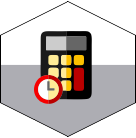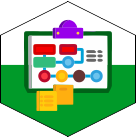
Why Attend
Managing the accounting and finance department requires building on various dimensions to keep the balance between growth and performance. ‘Modern Accounting and Finance Operations' presents a dynamic and modern approach to managing the accounting and finance operations on a strategical level, beyond the technical day-to-day skills.
Dimension 1 is about designing a Key Performance Indicator (KPI) measurement system which will serve as a cornerstone for managing the performance of the subsequent practices. Dimension 2 focuses on building teamwork, happiness, collaboration and self-mastery for the team which is a base to achieving better results. Dimensions 3 and 4 are focused on re-inventing processes while using innovation. Dimension 5 is focused on the satisfaction of internal and external customers with whom the accounting and finance teams interact. Dimensions 6 is about using all the previous practices to improve profitability.
Course Methodology
This course uses a mix of exercises, workshops, group case studies, and presentations based on the issues and challenges facing the participants. Conceptual ideas, rules, and best practices will also be discussed in selecting KPIs, process mapping, cost-saving techniques, and innovative tools.
Course Objectives
By the end of the course, participants will be able to
- Describe and explain the financial and non-financial KPIs of the accounting and finance team
- Build a knowledge sharing culture and individual development plans for employees
- Develop a plan to increase happiness and positive attitude in the workplace
- Apply up-to-date practices in process mapping, value mapping and process re-engineering
- Develop a practical survey to understand internal and external stakeholders' satisfaction from the accounting and finance operations
- Implement costs saving strategies and innovation initiatives
Target Audience
Professionals in the field of finance and accounting, directors, managers, supervisors, and finance professionals who desire to understand, apply and implement practical tools to enable them to structure and run the finance and accounting departments more effectively.
Target Competencies
- Develop financial and non-financial KPIs
- Sharing of professional knowledge
- Personal development
- Accounting and finance process analysis
- Problem solving and process re-engineering
- Change management and innovation in accounting and finance
- Risk management / Stakeholder orientation
- Cost management
Course
Outline
- What are Key Performance Indicators (KPIs)
- The crucial role of KPIs in managing performance
- Designing a KPI measurement system
- How KPIs should be linked to Key Result Areas (KRAs)
- Input KPIs, process KPIs, output KPIs, outcome KPIs
- Common problems with KPI systems
- Evaluating your existing KPI measurement system for enhancement opportunities
- Using KPIs in different management areas to assess performance
- Which financial KPIs do executives use?
- A&F KPIs: operational-performance related
- A&F KPIs: financial-performance related
Building the team's capabilities
- Knowledge sharing, learning and human capital growth
- Creating a culture of knowledge sharing
- Knowledge sharing models: codification versus personalization
- Placing incentives for A&F staff to share knowledge
- Employee learning frameworks: push versus pull approach
- Available “free†self-learning tools for A&F staff
- Criteria for selecting trainings from external providers
- Diversification of learning solutions
- On-the-job training methods
- Off-the-job training methods
- Creating action plans for A&F staff development programs
- Assessing succession plan for the A&F team
- Building individual development plans for team members
- Happiness and wellness in the workplace
- The right physical environment and work atmosphere
- The appreciation system: do you reward effort or results?
- Happy work protocols for different occasions
- Birthdays, outings and events
- Sports and wellness
- Motivating management styles: building trust relationship
- Happy employee/manager relationship
Accounting and finance process re-engineering
- Definition, elements and characteristics of a process
- Must-haves for each process
- Process approach to improvement of A&F function
- Advantages of process mapping
- The Plan, Do, Check, Act (PDCA) approach
- Types of mapping tools: simple flow charting, Swimlane, SIPOC
- Process-mapping softwares
- Best practices in process mapping
- Mapping an A&F process
- Value stream maps: value added and non-value added analysis
- Cycle time map: opportunities in terms of reducing cycle time and defects
- Lean thinking to reduce waste in processes
- 5S: a framework to organize and maintain your workplace
Roadmap for innovation in accounting and finance
- Which A&F processes require most time and effort?
- Automation opportunities in A&F
- Utilizing ERP solutions to close time gaps
- Eight essential attributes for innovation
- Steps for innovation and transformation
- Aligning key stakeholders
- Step 1: Understand the problem
- Step 2: Enlist champions for the tasks
- Step 3: Start with the end in mind
- Engaging the organization
- Step 4: Motivate stakeholders by articulating vision
- Step 5: Communicate
- Step 6: Act
- Step 7: Consolidate
Stakeholders’ satisfaction: internal and external
- A&F internal and external stakeholders
- Why stakeholders’ satisfaction is important?
- Using surveys and questionnaires as a tool for improvement
- How to set objective of surveys?
- How to write survey questions?
- How to ask?
- What do survey questions tend to measure?
- Sampling methods
- Administration and analysis of survey results
- The importance of demographics
- Simulation: building satisfaction survey
- Customers (A/R), suppliers (A/P), employees (payroll), banks (treasury), budgeting, control, financial reporting and analysis
Achieving realistic cost savings
- Importance of saving costs and improving productivity​
- External reasons for cost reduction and savings
- Advantages and disadvantages of saving costs
- Cost reduction decision table
- Example of capabilities developed by companies to reduce costs
- Strategic and tactical cost actions
- Shared service centers versus centralization versus outsourcing
- Organizations that would benefit from shared service centers
- Process of implementing a shared service center
- Cost management scenarios based on company’s situation
- How to play going forward
- Revenues and cost targets to increase shareholder value
- ​Limitations of simple employee lay-offs
- Use of target costing
- Control of maintenance, office supplies, theft and lawsuits
- ​10 steps to accomplish
cost reduction
Fee
₦129,000
Course Outline
Fill the form below and the full course content will be sent to you
-
Accounting & Finance

-
Leadership

-
Quality Control

-
Human Resources

-
Interpersonal Skills & Self Development

-
Secretarial & Administrative

-
Warehouse Management

-
Audit & Finance

-
Health And Safety

-
Contract, Project And Procurement Management

-
Planning And Strategy Management

-
Digital Innovation And Transformation

-
Data Management & Business Intelligence

-
Virtual Learning